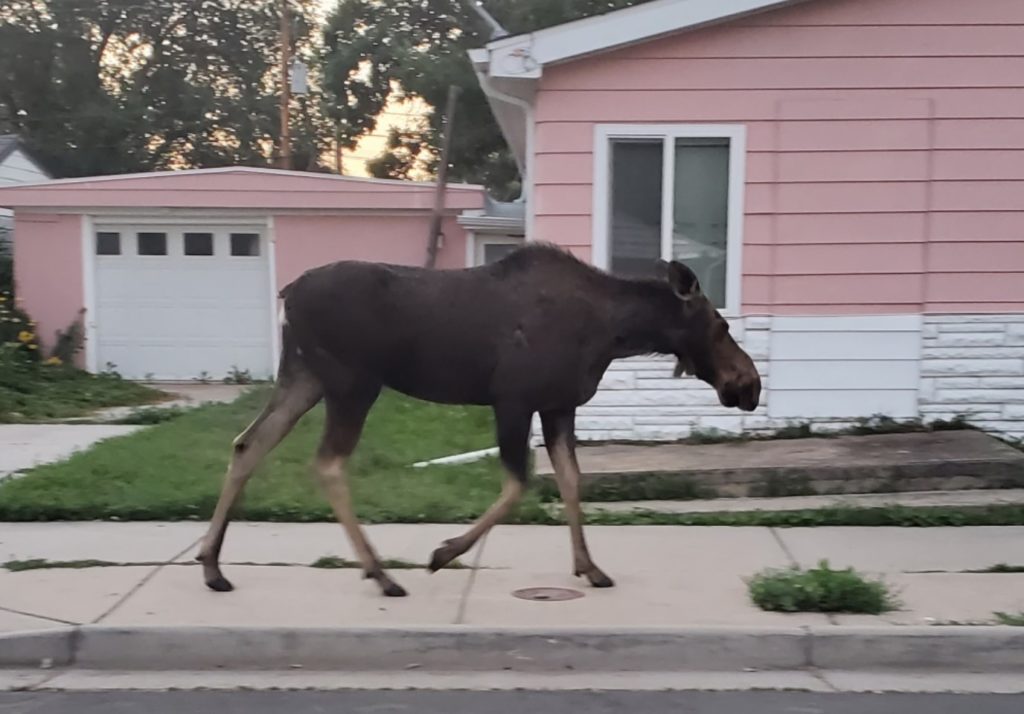A little girl was playing in the ocean with her family at Huntington Beach, California when a coyote came charging across the sand and attacked, putting the little girl in the hospital. Another coyote went after a child on her home’s front porch in Dallas.
Human encounters with angry wildlife are rare but seem to be increasing in recent years. It isn’t just the number of wildlife attacks, but their location, increasingly outside the animals’ natural habitat. People hiking in the mountains have always been vulnerable, but some highly publicized recent encounters have occurred not in the mountains, but in cities, towns, and neighborhoods.

A 650-pound moose crossed six lanes of rush-hour traffic in downtown Colorado Springs in 2020 before wildlife officials were able to capture and relocate it back to the mountains. Last year another moose made it to a backyard in the small town of Strasburg, on the plains 40 miles east of Denver. A bull elk stopped traffic in downtown Salt Lake City last month, as has happened in Greenville, South Carolina, Billings, Montana, Lakewood, Colorado and dozens of other cities.
Unfortunately, wildlife confrontations are not always peaceful. One black bear killed a woman in Durango, another attacked a 10-year-old boy in his Connecticut backyard, and another busted through a Medford, Wisconsin window to attack a couple inside their home. Recent bear attacks were also reported in Asheville, North Carolina and Strafford, Vermont, among others. Seventy people have been killed by brown bears in the U.S., 54 by black bears, at least 39 by alligators, and 57 by snakes. The most dangerous place seems to be Texas, where 520 people have been killed by animals in the last 20 years.
Why are human-wildlife conflicts apparently increasing? The conventional wisdom is that urban sprawl and the expansion of human infrastructure into wildlife territory leaves many animals with nowhere to go. But my friend Rob Gordon, America’s preeminent scholar and writer on this subject, suggests another possibility. Namely, that there may be more wildlife conflicts because there is more wildlife.
In a three-part series for the Daily Signal, Gordon looked at the populations of some of America’s most dangerous animals. He found that black bears, for example, “like many other U.S. species, are doing very well.” He cited the expanding range of bears in Massachusetts, for example, where they were rare by the mid-1800s, but now see a “dramatic population growth with perhaps 50 times more bears in the state today than just 50 years ago.” There are an estimated 17,000-20,000 black bears in Colorado now, and probably a half million in the U.S., excluding Alaska. Such successes are a credit to an American culture more sensitive than ever to the welfare of wildlife.
One of Gordon’s studies looked at the range of 43 key species, finding that nearly half occupy a range equal to or greater than their historic range. Atop that list are coyotes, which are native to the Rockies, but today roam the beaches of California and Central Park in New York City. They have expanded their range by nearly 30 states, he writes, and are now “too numerous to count.”
He demonstrates that conflicts with bears – outside national parks, forests, or wildlife refuges – were “not a result of bears fleeing rural areas because of habitat destruction. The cause is a dramatically growing bear population, resulting in bears wandering into suburban or even urban environments.”
Wildlife officials always point out, correctly, that attacks on humans are rare. Consider the odds when a couple people a year are attacked by bears – in a country with 330 million people and half a million bears. Still, conflicts will inevitably increase as wildlife populations increase. That’s why most states warn that people must become more aware of their cohabitation with potentially dangerous wild animals. It’s why we must be careful about habits that alter the behavior of wild animals, especially feeding them – which is illegal in Colorado and most other states. Feeding wild animals may seem compassionate, but because it is unreliable, it is often a death sentence for animals – and dangerous for people.
We may be more enlightened than ancestors who declared the only good wolf was a dead one. Today when we hear of wildlife attacks on humans, we are more likely to consider the plight of the poor animals, displaced from their homes by human population growth. There is some truth in that, but the reverse might also be true, that they sometimes result from growing animal populations.




Comments on this entry are closed.